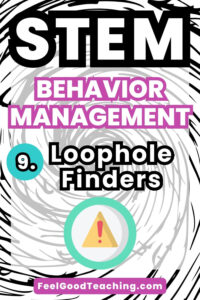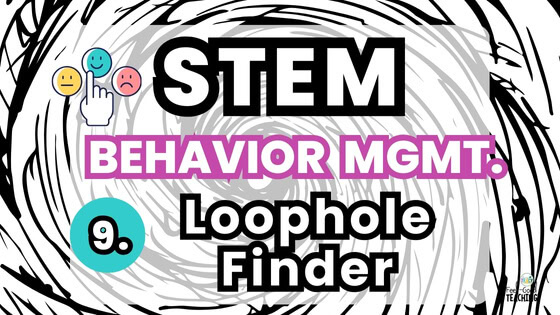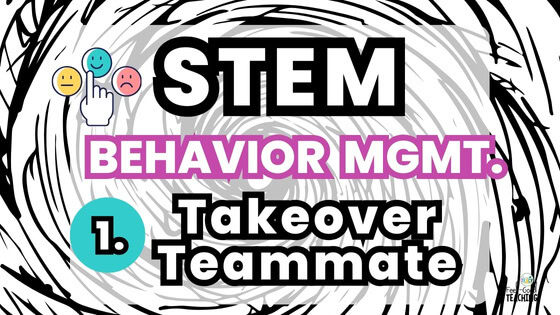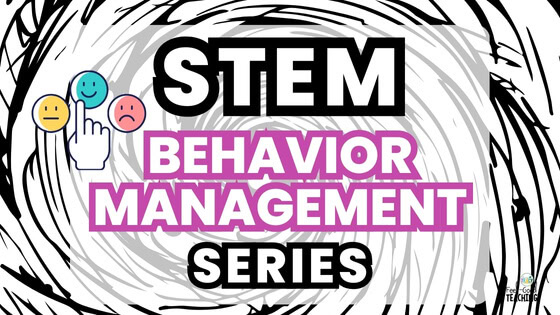This post is part of the series on STEM classroom management, where we explore subtle (and not-so-subtle) behaviors that can throw off collaboration and engagement during STEM time.
Today we’re zooming in on a sneaky issue: students who stretch, bend, or break the rules in the name of “efficiency” or “winning.”
Let’s meet: The Loophole Finder
Meet the Loophole Finder
Who They Are: This student is often incredibly sharp, creative, and engaged—but they love to push the boundaries. They:
- Stretch the criteria to the limit
- Find workarounds or shortcuts no one else considered
- Argue, “It doesn’t say we can’t…”
- Treat each STEM activity a personal challenge to defeat the spirit of what you intended for the lesson
And here’s my possibly unpopular opinion: This isn’t misbehavior; it’s critical thinking in action. Rather than shut it down, your job is to notice it, honor it, and decide if it reveals something you can improve in your challenge design.
Why It Matters
While it’s often not fun when a student violates the spirit of the challenge while staying within the criteria & constraints you laid out, it’s exactly the kind of thinking outside the box we’re trying to cultivate by doing STEM challenges in the first place:
1. Thinking critically
2. Questioning assumptions
3. Designing strategically
Sometimes, though, these workarounds create tension:
Teammates feel the design lacks integrity or creativity
Other groups feel the workaround creates an unfair advantage
The intent of the challenge gets lost
But here’s the key: if a student stays within the criteria and constraints, and still “breaks” the challenge, that’s on us – not them. It means our boundaries need adjusting.
Strategies for Supporting the Loophole Finder
Let’s talk about what to do before, during, and after the challenge to create a more balanced group dynamic.
🌍 Before the Challenge: Design with Intention
Write airtight criteria & constraints.
- If something is essential to the challenge’s purpose, make it explicit.
- Include phrases like “Must demonstrate structural stability” or “Design must be creative (or never-before-seen) and not copied from prior examples.”
Share the why behind the rules.
- Say: “We’re limiting materials to encourage creative thinking.”
- When kids understand the goal, they’re more likely to respect it.
Embrace loophole testing as part of your process
- Let students know: “If you find a loophole, that helps me improve the challenge. I appreciate it, and I may adjust the rules next time!”
⏱️ During the Challenge: Respond with Curiosity
1. Use questioning, not correction. Instead of saying, “That’s not allowed,” try: “Tell me how this fits the criteria.”
This invites students to explain their thinking—and often reflect on it, too.
2. Celebrate cleverness while clarifying intent
“Wow! Nice job finding a loophole. It’s not exactly in the spirit of what I intended, but that tells me I need to tweak the criteria for next time. You’re keeping me on my toes!”
3. Encourage reflection-in-action
“How do you think your approach affects your team’s creativity?”
“If every team did it this way, what might be gained or lost?”
4. Let it play out if it fits the rules. As long as the design meets the written criteria, let students test it. The real lesson often happens in the trial.
🔄 After the Challenge: Reflect & Refine
1. Host a design debrief
- Prompt: “Did anyone find a creative workaround today? What did we learn from that?”
- Help the class reflect on how clever thinking fits into innovation and integrity.
2. Ask: Did this reveal a gap in the criteria? If so, update the challenge before using it again.
3. Offer an optional iteration round
- Challenge students to redesign using improved constraints: “How could you preserve your creative solution while also meeting this new design goal?”
4. Let students help write better criteria next time. This increases ownership and makes the challenge more robust.
5. Recognize the skill of boundary-testing
“Finding a loophole takes sharp thinking. I’m impressed. Now let’s see if we can channel that brainpower into raising the bar even further.”
🧠 Reflection Prompts for Educators:
- Did my criteria and constraints clearly support the goals of the challenge?
- Did the student’s workaround demonstrate critical thinking and strategic design?
- Is there a way to preserve that ingenuity while improving the challenge next time?
Bottom Line: The Loophole Finder isn’t a troublemaker, they’re often your most strategic thinker. Instead of punishing them for seeing possibilities you didn’t anticipate, engage them in raising the bar. STEM is about creative problem-solving. Let’s make space for that even when it surprises us.
💡 Want a Free STEM Classroom Management Handbook?
I’m putting together a printable copy of these strategies as well as navigating other tricky STEM behaviors perfect for keeping in your lesson planner or sharing at your next PLC or team meeting. It will be sent to every subscriber on my email list when the series is complete. Sign up below to get on the list.
Coming Up in the Series…
The One-Track Thinker: the student who clings to one idea and resists feedback or iteration.
Explore all posts in the STEM Classroom Management Series here.
Pin it. Share it. Save it. You never know when you’ll need just the right strategy for just the right kid.




